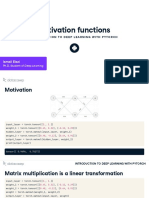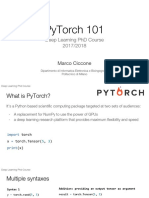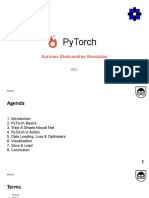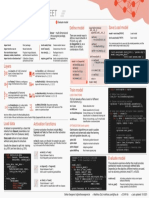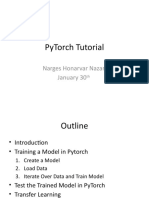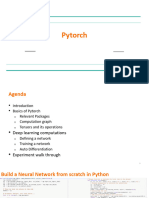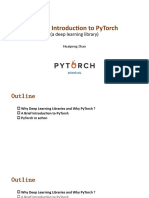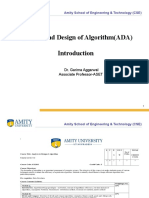Discovering
activation functions
between layers
INTRODUCTION TO DEEP LEARNING WITH PYTORCH
Maham Faisal Khan
Senior Data Science Content Developer
Limitations of the sigmoid and softmax function
Sigmoid functions:
Bounded between 0 and 1
Can be used anywhere in the network
Gradients:
Approach zero for low and high values of x
Cause function to saturate
Sigmoid function saturation can lead to
vanishing gradients during backpropagation.
This is also a problem for softmax.
INTRODUCTION TO DEEP LEARNING WITH PYTORCH
Introducing ReLU
Rectified Linear Unit (ReLU):
f(x) = max(x, 0)
for positive inputs, the output is equal to
the input
for strictly negative inputs, the output is
equal to zero
overcomes the vanishing gradients problem
In PyTorch:
relu = nn.ReLU()
INTRODUCTION TO DEEP LEARNING WITH PYTORCH
Introducing Leaky ReLU
Leaky ReLU:
For positive inputs, it behaves similarly to
ReLU
For negative inputs, it multiplies the input
by a small coefficient (defaulted to 0.01)
The gradients for negative inputs are never
null
In PyTorch:
leaky_relu = nn.LeakyReLU(negative_slope = 0.05)
INTRODUCTION TO DEEP LEARNING WITH PYTORCH
Let's practice!
INTRODUCTION TO DEEP LEARNING WITH PYTORCH
A deeper dive into
neural network
architecture
INTRODUCTION TO DEEP LEARNING WITH PYTORCH
Maham Faisal Khan
Senior Data Science Content Developer
Layers are made of neurons
Linear layers are fully connected
Each neuron of a layer connected to each
neuron of previous layer
A neuron of a linear layer:
computes a linear operation using all
neurons of previous layer
contains N+1 learnable parameters
where N = dimension of previous layer's
outputs
INTRODUCTION TO DEEP LEARNING WITH PYTORCH
Layer naming convention
INTRODUCTION TO DEEP LEARNING WITH PYTORCH
Tweaking the number of hidden layers
Input and output layers dimensions are fixed.
input layer depends on the number of features n_features
output layer depends on the number of categories n_classes
model = nn.Sequential(nn.Linear(n_features, 8),
nn.Linear(8, 4),
nn.Linear(4, n_classes))
We can use as many hidden layers as we want
Increasing the number of hidden layers = increasing the number of parameters = increasing
the model capacity
INTRODUCTION TO DEEP LEARNING WITH PYTORCH
Counting the number of parameters
Given the following model: Using PyTorch:
.numel() : returns the number of elements
model = nn.Sequential(nn.Linear(8, 4),
in the tensor
nn.Linear(4, 2))
total = 0
Manually calculating the number of
for parameter in model.parameters():
parameters:
total += parameter.numel()
first layer has 4 neurons, each neuron has print(total)
8+1 parameters = 36 parameters
46
second layer has 2 neurons, each neuron
has 4+1 parameters = 10 parameters
total = 46 learnable parameters
INTRODUCTION TO DEEP LEARNING WITH PYTORCH
Let's practice!
INTRODUCTION TO DEEP LEARNING WITH PYTORCH
Learning rate and
momentum
INTRODUCTION TO DEEP LEARNING WITH PYTORCH
Maham Faisal Khan
Senior Data Science Content Developer
Updating weights with SGD
Training a neural network = solving an optimization problem.
Stochastic Gradient Descent (SGD) optimizer
sgd = optim.SGD(model.parameters(), lr=0.01, momentum=0.95)
Two parameters:
learning rate: controls the step size
momentum: controls the inertia of the optimizer
Bad values can lead to:
long training times
bad overall performances (poor accuracy)
INTRODUCTION TO DEEP LEARNING WITH PYTORCH
Impact of the learning rate: optimal learning rate
INTRODUCTION TO DEEP LEARNING WITH PYTORCH
Impact of the learning rate: small learning rate
INTRODUCTION TO DEEP LEARNING WITH PYTORCH
Impact of the learning rate: high learning rate
INTRODUCTION TO DEEP LEARNING WITH PYTORCH
Without momentum
lr = 0.01 momentum = 0 , after 100 steps minimum found for x = -1.23 and y = -0.14
INTRODUCTION TO DEEP LEARNING WITH PYTORCH
With momentum
lr = 0.01 momentum = 0.9 , after 100 steps minimum found for x = 0.92 and y = -2.04
INTRODUCTION TO DEEP LEARNING WITH PYTORCH
Summary
Learning rate Momentum
Controls the step size Controls the inertia
Too small leads to long training Null momentum can lead to the optimizer being stuck in a
times local minimum
Too high leads to poor
Non-null momentum can help find the function minimum
performances
Typical values between 10−2
Typical values between 0.85 and 0.99
and 10−4
INTRODUCTION TO DEEP LEARNING WITH PYTORCH
Let's practice!
INTRODUCTION TO DEEP LEARNING WITH PYTORCH
Layer initialization
and transfer
learning
INTRODUCTION TO DEEP LEARNING WITH PYTORCH
Maham Faisal Khan
Senior Data Science Content Developer
Layer initialization
import torch.nn as nn
layer = nn.Linear(64, 128)
print(layer.weight.min(), layer.weight.max())
(tensor(-0.1250, grad_fn=<MinBackward1>), tensor(0.1250, grad_fn=<MaxBackward1>))
Layer weights are initialized to small values
Layer outputs can explode if inputs and weights are not normalized
Weights can be initialized using different methods (e.g., with a uniform distribution)
INTRODUCTION TO DEEP LEARNING WITH PYTORCH
Layer initialization
import torch.nn as nn
layer = nn.Linear(64, 128)
nn.init.uniform_(layer.weight)
print(custom_layer.fc.weight.min(), custom_layer.fc.weight.max())
(tensor(0.0002, grad_fn=<MinBackward1>), tensor(1.0000, grad_fn=<MaxBackward1>))
INTRODUCTION TO DEEP LEARNING WITH PYTORCH
Transfer learning and fine-tuning
Transfer learning: reusing a model trained on a first task for a second similar task, to
accelerate the training process.
import torch
layer = nn.Linear(64, 128)
torch.save(layer, 'layer.pth')
new_layer = torch.load('layer.pth')
INTRODUCTION TO DEEP LEARNING WITH PYTORCH
Transfer learning and fine-tuning
Fine-tuning = A type of transfer learning
Smaller learning rate
Not every layer is trained (we freeze some of them)
Rule of thumb: freeze early layers of network and fine-tune layers closer to output layer
import torch.nn as nn
model = nn.Sequential(nn.Linear(64, 128),
nn.Linear(128, 256))
for name, param in model.named_parameters():
if name == '0.weight':
param.requires_grad = False
INTRODUCTION TO DEEP LEARNING WITH PYTORCH
Let's practice!
INTRODUCTION TO DEEP LEARNING WITH PYTORCH


